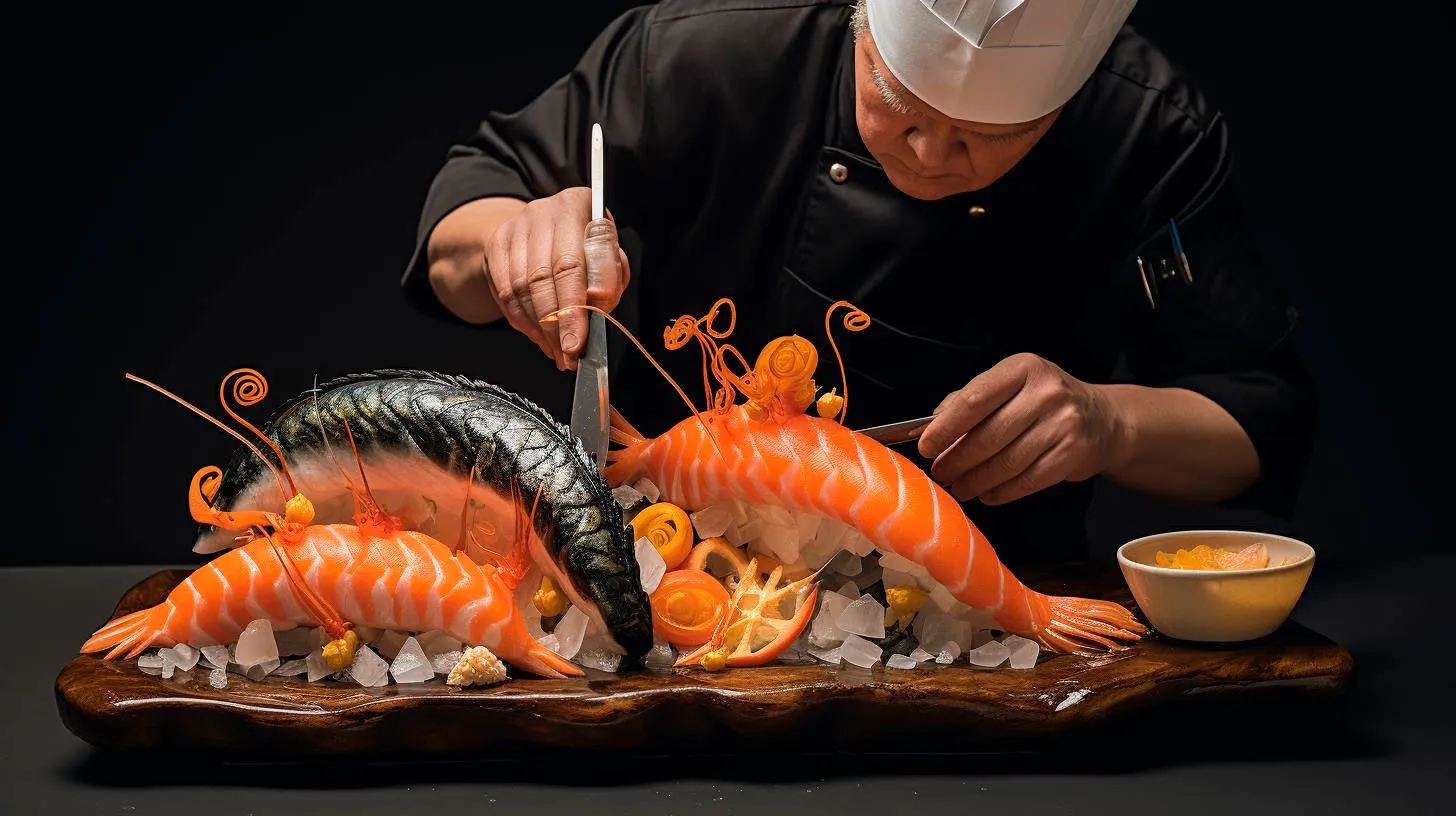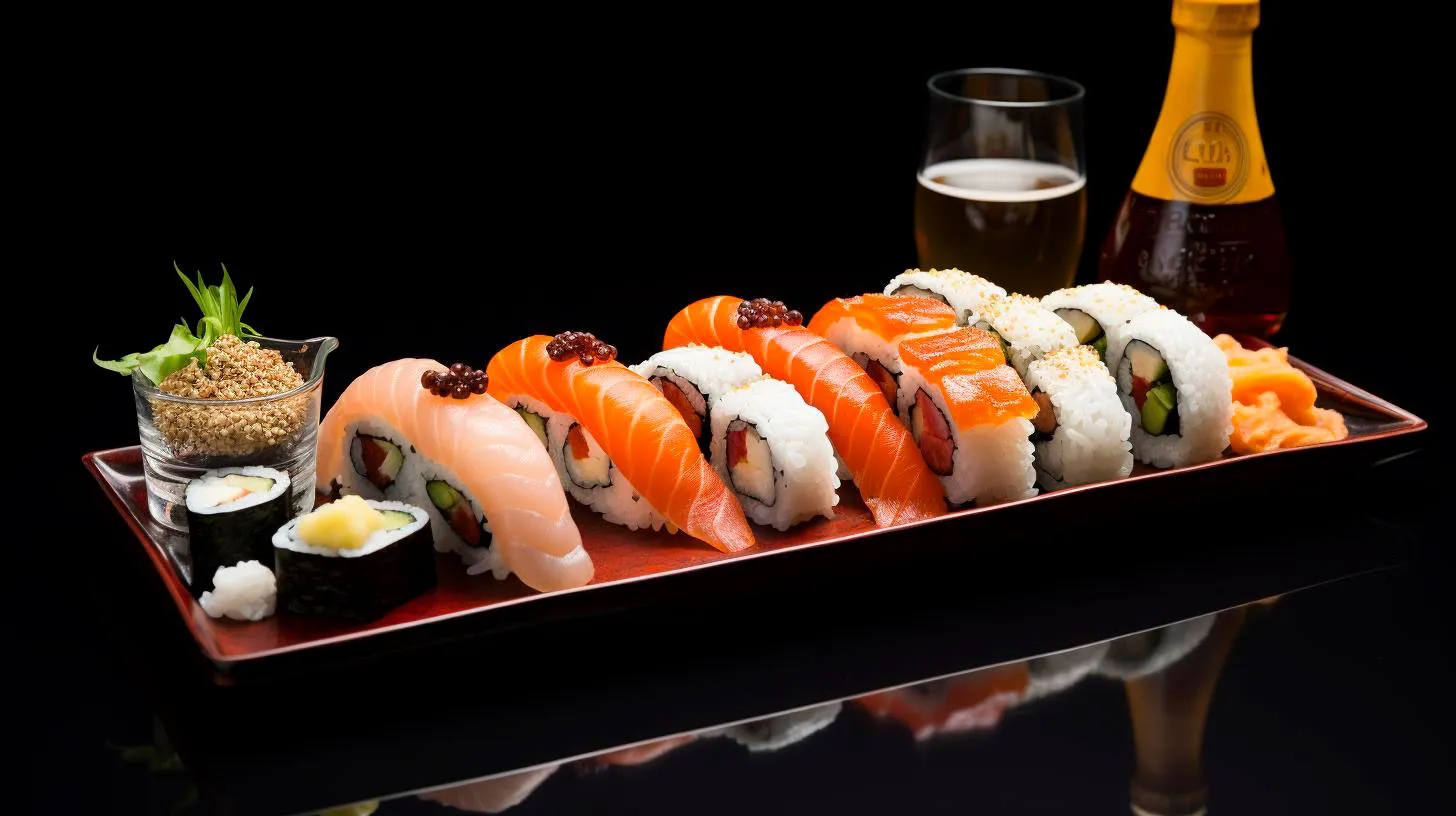The Evolution of Sushi Rolls: How Japan’s Iconic Dish Transformed Over Time
In this article, we will delve into the evolution of sushi rolls and how this iconic Japanese dish has transformed over time.
The Origins of Sushi
Sushi originated in Southeast Asia before making its way to Japan in the 8th century. Initially, sushi was a method of preserving fish by fermenting it with rice and salt. The rice acted as a natural preservative, allowing fish to be stored for extended periods. However, the sushi we know today, with its combination of vinegared rice and fresh seafood, evolved during the Edo period (1603-1868) in Japan.
The Birth of Sushi Rolls
It was during the Edo period that sushi transformed from a preservation technique to a beloved delicacy. It was during this time that sushi rice was flavored with vinegar, giving it a unique tangy taste. This marked the birth of nigirizushi, or hand-pressed sushi, where a small mound of vinegared rice was topped with thinly sliced fish. While nigiri sushi remains popular today, it was the introduction of sushi rolls, known as makizushi, that truly revolutionized the sushi experience.
Sushi rolls were initially created to offer a more filling meal while maximizing the use of ingredients. The first sushi rolls were simple and consisted of a seaweed wrapper, rice, and one ingredient placed in the center. However, as sushi gained popularity, chefs began experimenting with different ingredients and flavor combinations, leading to the development of diverse sushi roll styles.
The Modernization of Sushi Rolls
The evolution of sushi rolls continued to evolve throughout the 19th and 20th centuries, with new ingredients and techniques being introduced. The introduction of refrigeration and improved transportation methods allowed for the use of raw fish in sushi, expanding the possibilities for sushi roll fillings.
Types of Sushi Rolls
Today, sushi rolls come in a wide variety of styles. Some popular types of sushi rolls include:
- Maki Sushi: This is the most common type of sushi roll, consisting of rice and various ingredients rolled tightly in a sheet of seaweed (nori). Maki sushi is typically sliced into bite-sized pieces.
- Uramaki: Known as inside-out rolls, uramaki rolls have the rice on the outside and the nori inside. These rolls are often coated with sesame seeds or fish roe.
- Temaki: Temaki rolls are cone-shaped sushi rolls that are hand-rolled and filled with a variety of ingredients. They are often enjoyed as a casual, handheld sushi option.
- Futomaki: Futomaki rolls are larger in size compared to other sushi rolls and usually contain multiple fillings. They are often served during special occasions and celebrations.
The Impact of Western Influence
As sushi gained popularity worldwide, its flavors and ingredients began to adapt to local palates. The introduction of the California Roll in the 1960s marked a significant milestone, as it replaced raw fish with avocado, cucumber, and crab meat to cater to American tastes. This fusion roll was the gateway for many people trying sushi for the first time, paving the way for further experimentation and innovation.
Today, sushi rolls continue to evolve, with innovative combinations and unique ingredients being incorporated into traditional recipes. The fusion of different culinary techniques and flavors has resulted in an exciting and diverse sushi culture that appeals to people around the globe.
Key Takeaways
- The evolution of sushi rolls from a preservation technique to a culinary delicacy happened during the Edo period in Japan.
- Sushi rolls offer a wide variety of styles, including maki sushi, uramaki, temaki, and futomaki.
- Western influences have led to the creation of fusion sushi rolls, incorporating local ingredients and flavors.
- Sushi rolls continue to evolve and innovate, keeping the culinary experience exciting and diverse for sushi enthusiasts worldwide.
In conclusion, sushi rolls have come a long way since their humble origins as a preservation technique. From simple ingredients wrapped in seaweed to elaborate rolls bursting with flavors, sushi has remained an emblem of Japanese cuisine. Its evolution showcases the creativity and adaptability of chefs worldwide, making sushi rolls a beloved dish for generations to come.
From Street Food to Global Phenomenon: The Surprising Journey of Sushi Rolls
The Origins of Sushi Rolls
Sushi, as we know it today, can be traced back to ancient Japan. However, it wasn’t always the intricate and artistic dish we are accustomed to. In fact, sushi’s origins can be traced back to a simple preservation technique known as “Narezushi.” Fish, mainly caught from rivers, was fermented with rice and salt for several months, allowing it to be preserved and consumed later. During the Edo period (1603-1868), a new form of sushi called “Edomae-zushi” emerged, where the fermented fish was taken out, and the rice was seasoned with vinegar, creating a distinctive sour taste.
However, the sushi roll, also known as makizushi, didn’t make its appearance until the 19th century. It is believed that Hanaya Yohei, a sushi chef in Tokyo, was the one who revolutionized sushi by combining rice, fish, and vegetables in a rolled seaweed wrap called nori. This innovative creation made sushi portable and convenient, paving the way for its popularity as a street food.
The Cultural Significance of Sushi Rolls
Sushi rolls are not only a culinary delight but also hold immense cultural significance in Japan. They represent the delicate balance of flavors, textures, and aesthetics that are deeply ingrained in Japanese cuisine. The art of sushi-making, known as “sushijutsu,” has been elevated to a level of craftsmanship that requires years of training to master.
Traditionally, sushi was primarily consumed during celebrations and special occasions. However, as Japan underwent rapid modernization and urbanization in the late 19th and early 20th centuries, sushi rolls became more readily available on the streets of Tokyo. This accessibility allowed people from all walks of life to experience the exquisite flavors of sushi.
The Global Journey of Sushi Rolls
While sushi rolls originated in Japan, their popularity quickly spread beyond its borders. The invention of refrigeration and advances in transportation made it possible to export sushi to different parts of the world. The United States played a crucial role in popularizing sushi internationally.
In the early 1960s, sushi gained traction in California, with the opening of the first sushi restaurant in Los Angeles. It quickly became a favorite among Hollywood celebrities and trendsetters. From there, sushi’s popularity spread across major cities in the United States and eventually reached other countries. Today, sushi is readily available in most cities worldwide, with numerous sushi chains, restaurants, and takeout options catering to sushi lovers.
The Advantages of Sushi Rolls
What makes sushi rolls so appealing to a global audience? Let’s take a look at some of the key advantages:
- Variety: Sushi rolls offer a diverse range of flavors and combinations, providing options for everyone’s taste preferences.
- Healthy Option: Sushi rolls are often seen as a healthier alternative to fast food, as they typically include fresh ingredients such as fish, vegetables, and seaweed.
- Portability: The compact nature of sushi rolls makes them a convenient on-the-go meal or snack.
- Culinary Adventure: Sushi rolls introduce people to unique flavors and ingredients they might not have encountered before, making it an exciting culinary exploration.
Key Takeaways
Sushi rolls have come a long way since their humble origins as a preserved fish and rice dish. From the streets of Tokyo to global popularity, sushi has captured the hearts and taste buds of people worldwide. This beloved Japanese creation represents the perfect marriage of tradition, cultural significance, and gastronomic craftsmanship.
Whether you enjoy a classic tuna roll, a creative fusion creation, or a vegetarian delight, sushi rolls offer a culinary adventure that continues to captivate food enthusiasts around the globe. So next time you indulge in this delightful delicacy, remember the surprising journey that brought sushi rolls to your plate.
The Origin of Sushi Rolls: Unveiling Ancient Culinary Traditions
While sushi rolls are now a staple in both traditional and modern Japanese cuisine, their origin can be traced back to ancient times. Join us on a culinary journey as we delve into the fascinating history and evolution of sushi rolls.
The Beginnings of Sushi
The roots of sushi can be traced back as early as the 2nd century A.D. in Southeast Asia. The ancient practice of preserving fish by fermenting it with rice and salt led to the initial creation of what we now call sushi. During this time, sushi was primarily used as a means to preserve fish, allowing people to store fish for extended periods in a time when refrigeration was nonexistent.
Over time, this preservation method evolved, and during the 8th century, sushi rapidly gained popularity in Japan. The Japanese people began consuming both the fish and the rice, enhancing the flavors by adding vinegar to the rice during the fermentation process.
The Birth of Sushi Rolls
As sushi gained traction in Japan, it went through a series of transformations. One of the significant evolutions of sushi was the introduction of nori, a type of edible seaweed, during the Muromachi period (1336-1573). This invention marked a turning point in the history of sushi, as it enabled the creation of the sushi roll we know today.
Initially, sushi was consumed exclusively by the aristocrats and was served as bite-sized pieces. However, the introduction of nori allowed for the inclusion of a variety of ingredients in larger portions, leading to the birth of sushi rolls. These rolls, also known as makizushi, consisted of rice, fish, and vegetables wrapped in a sheet of nori.
Sushi rolls provided a convenient, portable, and easy-to-eat option for people on the go. The development of sushi rolls also gave rise to various regional specialties across Japan, each offering distinctive flavors and ingredients.
The Evolution of Sushi Rolls
Throughout history, sushi rolls have continued to evolve, incorporating different ingredients and preparation techniques. Here are some notable milestones in the evolution of sushi rolls:
1. Nigiri Sushi
- Nigiri sushi, which consists of a mound of vinegared rice topped with a slice of fish or seafood, emerged in the 19th century.
- Key Takeaway: Nigiri sushi showcases the delicate flavors of the fish or seafood, allowing it to take center stage.
2. California Roll
- In the 1960s, the California roll was created in Los Angeles, catering to Western tastes by using avocado instead of raw fish.
- Advantage: The California roll played a vital role in popularizing sushi around the world, especially among those who were initially apprehensive about consuming raw fish.
3. Fusion Sushi
- With globalization, sushi has merged with various culinary influences, giving rise to fusion sushi. This style incorporates ingredients and flavors from different cuisines, such as spicy tuna rolls and tempura sushi.
- Feature: Fusion sushi offers a creative and unique twist on traditional sushi, catering to diverse palates.
A Global Culinary Phenomenon
Today, sushi rolls have transcended geographical boundaries, becoming a beloved culinary phenomenon worldwide. More than just a meal, sushi has become a cultural symbol, representing Japanese traditions and culinary finesse.
According to recent statistics, sushi consumption has skyrocketed, with over 2,500 sushi restaurants in the United States alone. The global sushi market is estimated to reach a value of $22.6 billion by 2027, showcasing the immense popularity and growth of this ancient culinary art form.
So the next time you savor a delectable sushi roll, remember its roots go back centuries, reflecting the ingenuity and artistry of ancient culinary traditions. Let the flavors transport you to a time when sushi was a simple preservation method, ultimately transforming into a global delicacy that continues to captivate food lovers around the world.
Sushi Beyond Borders: Exploring Cultural Influences on Sushi Roll Varieties
The Fusion of Flavors
Sushi rolls, known as “makizushi” in Japanese, consist of rice and various fillings wrapped in seaweed. Traditionally, sushi rolls were quite simple, with ingredients like fresh fish and vegetables. However, as sushi found its way to different countries, local flavors and ingredients were incorporated, resulting in a plethora of sushi roll varieties.
Let’s take a look at some of the cultural influences that have shaped sushi roll varieties around the world:
1. American Influence
In America, sushi gained immense popularity during the 1960s and 1970s. American sushi rolls, commonly known as “California rolls,” were introduced in Los Angeles. What sets them apart is the use of avocado and crab meat rather than raw fish. To make them more appealing to American palates, they were rolled with the seaweed on the inside, making them easier to eat for those unfamiliar with traditional sushi.
Key Takeaway: California rolls demonstrate how sushi adapted to local tastes, introducing new ingredients and altering traditional presentation styles.
2. South American Influence
In South America, particularly in Brazil, sushi rolls took on a unique twist. Due to the Japanese diaspora in Brazil, sushi rolls gained a significant following. However, instead of using traditional Japanese ingredients, Brazilians incorporated local flavors such as cream cheese, mango, and even deep-frying certain rolls. These Brazilian-style sushi rolls, known as “temaki,” became incredibly popular not only in Brazil but worldwide.
Key Takeaway: The fusion of Japanese and Brazilian flavors showcases how adaptability and experimentation can create exciting sushi roll variations.
3. Western Influence in Asia
In recent years, there has been a growing trend of Western-influenced sushi rolls in Asia, particularly in countries like China and Korea. These rolls often feature ingredients like mayonnaise, teriyaki sauce, and even fried chicken. While purists may argue it strays from the authenticity of traditional sushi, these rolls have gained popularity among younger generations for their bold flavors and unique combinations.
Key Takeaway: Western-influenced sushi rolls in Asia demonstrate how cultural exchange can result in innovative and modern interpretations of classic dishes.
Advantages of Diverse Sushi Roll Varieties
The fusion of different flavors and influences in sushi roll varieties comes with several advantages:
- Expanded Culinary Options: Sushi roll varieties open up a world of possibilities, catering to different dietary preferences and taste preferences.
- Cultural Exchange: Sushi roll varieties reflect the cultural exchange between different countries, promoting understanding and appreciation of diverse culinary traditions.
- Creativity and Innovation: The evolution of sushi roll varieties encourages chefs to experiment with new flavors, textures, and presentations, pushing the boundaries of traditional sushi-making.
Key Takeaways
Sushi roll varieties have transcended borders, incorporating diverse cultural influences and flavors. This fusion has resulted in unique and innovative roll creations that continue to captivate sushi enthusiasts worldwide. From the American invention of California rolls to the Western-inspired rolls found in Asia, sushi has truly become a global delicacy.
Remember these key takeaways:
- Sushi rolls have adapted to local tastes and ingredients, incorporating cultural influences from around the world.
- The fusion of flavors has expanded culinary options, promoted cultural exchange, and encouraged creativity and innovation.
- Exploring different sushi roll varieties allows you to experience the rich tapestry of global culinary traditions.



